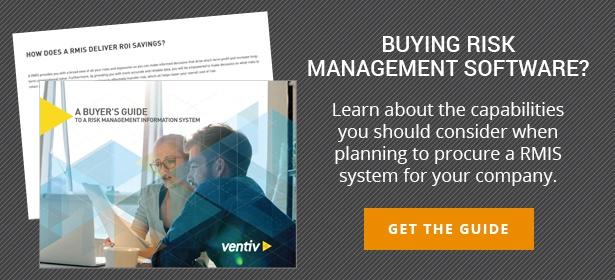
Some may call it a Risk Management Ecosystem, some may call it a Risk Management Supply Chain, some might not even think about it at all. In my view, the Risk Management Ecosystem is a living community that interacts and is interdependent, much like a natural ecosystem. Each part will be different from each of the others, serving its own particular niche in the sustenance and health of the overall system and, as the senior leader in risk management, it is your unique responsibility to assemble, nurture and manage the entire ecosystem to achieve the best performance for your company.
So, what does a Risk Management Ecosystem consist of and how do the parts interact?
- Executive Management – While you, as the risk management leader may not assemble this part of your ecosystem, it is certainly there, providing direction, strategy, budgets and oversight. As the risk management leader in your company, you have to act as a bit of a shock absorber between this group and the rest of your ecosystem, making sure they are fully aware of the risk activities, while sheltering them from the day-to-day trauma and drama that takes place in risk management.
- Risk Management Staff – Your primary assembly task, the development of internal staff. Recruiting, hiring and actively managing a group of skilled professionals who have to work closely with one another as well as interact with all of the other parts of your ecosystem is very challenging.
- Broker/Agent – Whether you know it or not; whether you like it or not, these people are your primary face in the insurance marketplace. They will be a huge part of your ecosystem, in some cases, they may even have some responsibility to assemble and manage some of the sub-components. This player has to be selected carefully, perhaps even more carefully than your direct risk management staff. Once selected, they have to be managed with care and respect. It is your responsibility to assure that their behavior in the Risk Management Ecosystem closely aligns with your mission and values and that they reflect you and your risk management programs with honor and integrity. If you, as the leader of the Risk Management Ecosystem, are not completely and intimately familiar with what and how your broker or agent are representing you in the marketplace, the entire ecosystem can fail. The broker or agent is an extension of your market presence, but they are not your surrogate as leader of the risk management function, as much as they might want to be.
- TPA or Carrier Claims Unit – Every company has a philosophy on claim handling. For some, the timeliness and accuracy of reserving and payments are paramount, to others complete investigation and active litigation of disputed matters is at front-of-mind. Whatever your claim philosophy, the claim service provider in your Risk Management Ecosystem has to be chosen to fully and accurately reflect the values of your organization. They will have to interact effectively with the broker/agent group, as well as with the actuaries and your internal staff. This group will also require close and very active management attention to assure that they remain aligned with strategy and philosophy and that they execute their role in the Risk Management Ecosystem at the highest level of effectiveness and integrity. Much like the brokers or agents, the claim group represents your company with claimants and their representatives; groups that are generally in an adversarial position to start with your company. Many risk management leaders use consultants or broker/agent support to review and audit claim activity, so there is another set of co-dependencies for you to be aware of and to manage actively.
- Captive Manager – While you and your executive management are going to have active oversight of the captive manager, their day-to-day activities are generally out of sight from the parent. As an active member of your Risk Management Ecosystem, the captive manager will interact with legal, finance, claims, tax, underwriting, reinsurance and the broker/agent segments as they discharge their responsibilities. In your role as the risk management leader, you have the direct responsibility to understand and manage the interactions among and between these parties to achieve optimal success of the captive insurance entity.
- Actuarial Consultant – Interacting with claims management, finance and other parts of your Risk Management Ecosystem, the actuaries are a driver of the expense side of your risk management equation. They must have a thorough working understanding of your claim philosophy and the operational details of your company so that their models can reflect the realities of your business. To a great extent, the actuarial process may appear to be an exercise of plugging your loss numbers into several well-recognized mathematical models, but the contribution by a highly professional and well managed actuary contributes heavily to effective forecasting and management of the ultimate loss equation and directly impacts future pricing on the underwriting side. Their ability to interact effectively with all of the other parts of your Risk Management Ecosystem requires your personal involvement to maintain philosophical alignment and an accurate financial strategy.
- Direct Underwriters – This component of your Risk Management Ecosystem interacts with almost all of the other components at some point in their process, and have long and deep relationships of their own with both broker/agent and claims segments. Those relationships have to be understood and honored as you manage the interactions in the best interest of the health of your Risk Management Ecosystem. Your relationship with the underwriting community has to be both deep and wide and it is never a best practice to leave the nurturing of this relationship to another member of your Risk Management Ecosystem. These underwriters must enjoy access to you, and you conversely, to them, without unintended filtering or muting of your messages regarding strategy and direction of the whole Risk Management Ecosystem. As the risk management leader, the underwriters need to look to you as the enabler of their role in the overall group.
- Reinsurance Underwriters – These folks are a bit of a subset of the direct underwriter category in your Risk Management Ecosystem. Like the direct underwriters, this group requires careful care and feeding so that they have a positive view of your risk. Keep in mind that reinsurers are the providers of the “raw material” that drives the product pricing of direct underwriters. Whether the reinsurance underwriters support your captive, or are more behind the scenes of your primary property or casualty insurer, you need to know who these people are and what their business values are, because, they will impact your success in the insurance marketplacee.
- Risk Management Consultants – This is a role in your Risk Management Ecosystem that may be filled by your broker or agent, maybe your outside audit firm or by specialist consulting firms. However you fill this role as you assemble your ecosystem, it is an important function that helps all of the other components stay fresh and current. To serve you effectively, these consultants must be chosen carefully, bearing in mind that they are advisors to you, in your role as risk management leader, they are not your surrogate.
Perhaps the glue that can hold all of the other parts of your Risk Management Ecosystem together is the Risk Management Information System (RMIS). Not just a claim management system, but a dynamic management information system that ties together all of the other components; underwriting, brokers and agents, claim providers and all of the other members of the Risk Management Ecosystem contribute to and draw data from the RMIS.
As the risk management leader, it is crucial to select a fully capable system that has the power and functionalities to not only contribute to the success of the other component parts, but to empowers you to effectively keep updated on the activities of the component parts of your Risk Management Ecosystem. Once selected and implemented, the RMIS requires knowledgeable care and feeding to assure that the system provides the capabilities and services that all of the component parts require to achieve and maintain optimal performance.
 Jeff Gehrke is Ventiv's Chief Risk Technology Evangelist. Contact Jeff at Jeff.Gehrke@ventivtech.com or +1.720.445.9531. Connect with Jeff on LinkedIn: https://www.linkedin.com/in/jeffjgehrke
Jeff Gehrke is Ventiv's Chief Risk Technology Evangelist. Contact Jeff at Jeff.Gehrke@ventivtech.com or +1.720.445.9531. Connect with Jeff on LinkedIn: https://www.linkedin.com/in/jeffjgehrke









 Jeff Gehrke is Ventiv's Chief Risk Technology Evangelist. Contact Jeff at
Jeff Gehrke is Ventiv's Chief Risk Technology Evangelist. Contact Jeff at 



